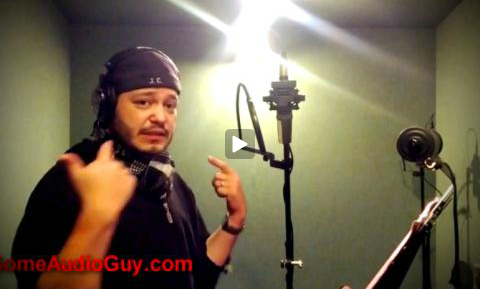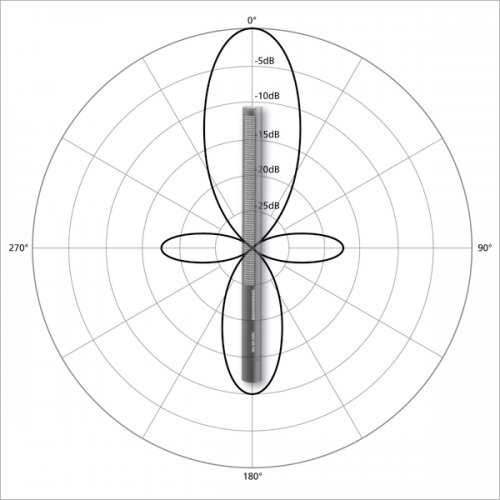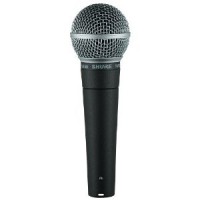Microphone Proximity Effect
 My wonderful friend and colleague, Juan Carlos Bagnell, runs a fantastic blog called, The Ramblings of Some Audio Guy. On it, he posts his wisdom, tips and musings on the world of voice over and recording technology. Juan’s pithy insights into voice over come from his years working both as a voice over agent and more recently as a booth director for voice over projects at The Voicecaster, a famous casting agency in Los Angeles.
My wonderful friend and colleague, Juan Carlos Bagnell, runs a fantastic blog called, The Ramblings of Some Audio Guy. On it, he posts his wisdom, tips and musings on the world of voice over and recording technology. Juan’s pithy insights into voice over come from his years working both as a voice over agent and more recently as a booth director for voice over projects at The Voicecaster, a famous casting agency in Los Angeles.
Juan just put up a great video post about proximity effect. For those of you who’ve listened to episode 11 and episode 12 of my podcast, I talked at length about microphone technology as well as microphone pickup patterns. I mentioned the fact that a microphone with a cardiod pickup pattern will produce what’s called a proximity effect, meaning that the closer you get to the microphone, the more low end or bass will be amplified by the microphone.
Well Juan has posted a wonderful video demonstration of this phenomenon in action on his blog. It’s entitled, The Proximity Effect and You! I highly recommend you check it out!
VAM 012 | Microphone Basics, Part 2 – Pickup Patterns
Welcome to episode 12 of the Voice Acting Mastery podcast with yours truly, Crispin Freeman!
As always, you can listen to the podcast using the player above, or download the mp3 using the link at the bottom of this blog post. The podcast is also available via the iTunes Store online. Just follow this link to view the podcast in iTunes:
http://www.voiceactingmastery.com/podcast
In this episode, I continue my explanation of microphone basics. Specifically, I talk about the directionality or “pickup pattern” of a microphone.
As little as 5 or 10 years ago, no voice actor needed to understand any of the details of how or why a microphone worked. However, in order to be competitive in today’s market, every voice actor is expected to have their own home recording studio. That means that you need to be able to produce professional sounding tracks yourself. It’s vital, therefore, to understand some of the basic attributes of microphones and how they function so that you can sound as good as possible.
The directionality or pickup pattern of a microphone refers to how that mic treats sounds coming at it from different directions. Does the microphone capture all sounds equally from all directions, or does it prefer sound from one direction and reject sound from other directions? All microphones break down into two types:
- Omnidirectional Microphones
- Unidirectional Microphones
There are many different types of unidirectional mics, but the most common used in voice over uses a cardioid polar pattern. It’s named that because it favors sound from the front, but rejects sound from the rear. This creates a polar pattern graph that looks “pinched off”, almost like an upside-down heart. Another common pattern is the “shotgun” pattern that’s used for recording actors at a distance on TV and movie shoots.
Here are some pictures of the three polar patterns I mention in the podcast:

Omnidirectional Polar Pattern

Cardioid Polar Pattern

Shotgun Polar Pattern
All unidirectional mics, including the cardioid and shotgun patterns, also exhibit a behavior where the closer a vocalist gets to the microphone, the more bass or low frequency sound is recorded. This bass buildup is called Proximity Effect and can be used to create different effects when recording. I discuss all these topics at great length in the podcast. I hope you enjoy it!
If you have any questions, please post your question as a comment to this blog post. Chances are, someone else has a similar question. By posting your question here on the blog, I get to communicate with all of you at once.
Thanks for listening!
Download Voice Acting Mastery Episode #12 Here (MP3)
VAM 011 | Microphone Basics, Part 1 – Dynamic vs. Condenser
Welcome to episode 11 of the Voice Acting Mastery podcast with yours truly, Crispin Freeman!
As always, you can listen to the podcast using the player above, or download the mp3 using the link at the bottom of this blog post. The podcast is also available via the iTunes Store online. Just follow this link to view the podcast in iTunes:
http://www.voiceactingmastery.com/podcast
In this episode, I explain the basics of how a microphone works. I also outline the differences between the two dominant types of microphones in voice acting, dynamic and condenser microphones.
Historically, microphone technology was the responsibility of the recording engineer. It used to be that you could spend your entire voice acting career not knowing how a microphone worked as long as you knew which side of it to talk into. Those days are now gone. In the age of the internet, voice actors are expected to be able to make professional quality recordings from their home studios. A solid understanding of microphones and how they function is invaluable to understanding how to use the most important tool a voice actor has.
While there are many different types of microphone technology, there are two that have become dominant in the world of voice over:
- Dynamic Microphones
- Condenser Microphones
Here are some pictures of the two microphones I mention in the podcast, the Shure SM58 Dynamic microphone and the Neumann U87 Condenser microphone:
Shure SM58 – Dynamic
Neumann U87 – Condenser
If you have any questions, please post your question as a comment to this blog post. Chances are, someone else has a similar question. By posting your question here on the blog, I get to communicate with all of you at once.
Thanks for listening!
Download Voice Acting Mastery Episode #11 Here (MP3)
VAM 010 | How to Practice Voice Acting Anywhere
Welcome to episode 10 of the Voice Acting Mastery podcast with yours truly, Crispin Freeman!
As always, you can listen to the podcast using the player above, or download the mp3 using the link at the bottom of this blog post. The podcast is also available via the iTunes Store online. Just follow this link to view the podcast in iTunes:
http://www.voiceactingmastery.com/podcast
In this episode, I give practical advice on how to practice your voice acting skills no matter where you are.
So many of my listeners have told me how much they enjoy the podcast. Some listeners espouse a belief that because they’re not located in the right area that they are unable to improve their voice acting skills. I decided to dedicate this entire episode to giving you practical ideas about how to practice voice acting no matter where you’re located.
The truth of the matter is, if you really want to do something, nothing will stop you. This is true in all aspects of life. A burning desire to achieve a goal will inspire a resourcefulness in you that will surprise you.
One of the most important aspects is identifying yourself as a voice actor and then asking yourself a series of logical questions:
- I am a voice actor. What does a voice actor do?
- A voice actor acts. What is acting?
- Acting is playing pretend so believably that people will pay you to do it. How do you achieve that level of skill?
- By practicing. Where does one practice acting?
That is the question I spend most of the episode answering. There are all sorts of places you can practice your acting skills and I address many of them in this podcast including:
- Classes: High School, College and Community College
- Community Theater: Acting with a multi-generational troupe of performers is enlightening
- Online Voice Acting Communities: Websites where you can post your work and get feedback
- Individual Study: Mimicking other voice actors can help you expand your range
I’m sure many of you out there have even more ideas about how one can practice their voice acting no matter where you’re located. I look forward to your suggestions, advice and comments here on the blog!
If you have any questions, please post your question as a comment to this blog post. Chances are, someone else has a similar question. By posting your question here on the blog, I get to communicate with all of you at once.
Thanks for listening!
Download Voice Acting Mastery Episode #10 Here (MP3)
VAM 006 | Interview with Wes Davis, Part 1
Welcome to the sixth episode of the Voice Acting Mastery podcast with yours truly, Crispin Freeman!
As always, you can listen to the podcast using the player above, or download the mp3 using the link at the bottom of this blog post. Also, the podcast is now available via the iTunes Store online. Just follow this link to view the podcast in iTunes:
http://www.voiceactingmastery.com/podcast
This is the first part of my interview with Wes Davis, a young and talented voice actor who was gracious enough to sit down with me and talk about his experiences breaking into the voice over business. I think you’ll find it useful to hear the challenges he faces today when approaching voice acting professionally especially in contrast to my experiences breaking in back in the late 1990’s. If you’d like to learn more about Wes, feel free to check out his voice acting website:
In this episode, I ask Wes a number of different questions including:
- What inspired you to become a voice actor?
- What has the journey of an aspiring voice actor been like?
- Have you ever been discouraged trying to break into the business?
- How did you first voice acting job go?
In the next episode, Wes and I will be discussing how he goes about finding voice acting gigs, his experiences with his agent and much more!
As always, I welcome your questions and feedback! If you feel inspired, please leave a comment on this blog post.
Thanks for listening!
Download Voice Acting Mastery Episode #6 Here (MP3)
VAM 002 | 7 Most Common Questions About Voice Acting, Part 2
Welcome to the second episode of the Voice Acting Mastery podcast with yours truly, Crispin Freeman!
As always, you can listen to the podcast using the player above, or download the mp3 using the link at the bottom of this blog post. Additionally, I’ll be submitting the podcast feed to iTunes in the near future, so you’ll be able to subscribe through the iTunes Music store if you’d like. I’ll let you know when that’s up and ready to go!
This is the second in a series of episodes I’ve entitled the 7 Most Common Questions I get asked about voice acting. If you haven’t listened to Episode 1, I highly recommend you go back and check it out! Here’s the link to the blog post with the first episode:
Voice Acting Mastery, Episode #1
In Episode 2, I’ll be answering questions 2, 3 & 4 which are:
2. People tell me I have a good voice. Should I get into voice acting?
3. How do I know if I have enough talent to be a voice actor?
4. What recording equipment do I need?
I get these questions a lot, and the answers to them may surprise you! So listen using the player above or download the podcast below!
If this episode sparks any thoughts from you, please let me know by leaving a comment on this blog post!
Thanks for listening!
Download Voice Acting Mastery Episode #2 Here (MP3)


